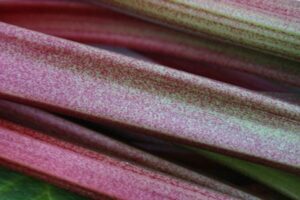Rhubarb

Contents:
Season for Rhubarb
Rhubarb Described
How to Buy and Store Rhubarb
How to Cook Rhubarb
Health Benefits of Rhubarb
Why Buy Natural and Organic Rhubarb
Season for Rhubarb April – October
Rhubarb Described
Though we Americans officially proclaimed that rhubarb be a fruit owing to its general uses (dubbed the “pie plant”), botanically speaking, rhubarb is a leafy green vegetable. The thick, celery-esque stalks of this buckwheat-family member have long been used medicinally but only recently become of gastronomical use. Most rhubarb fall into two basic types: hothouse and field grown. Hothouse – or strawbery – rhubarb has pink to light red stalks and a more delicate texture, whereas field-grown – or cherry – rhubard have bright red stalks and are more robust and hearty in both flavor and texture.
How to Buy and Store Rhubarb
When it comes to rhubarb, feel free to choose from a range of colors (pink to red to green), keeping in mind that red stalks tend to be sweeter and the deeper the hue, the healthier the stalk. Look for bunches that have fresh-looking and blemish-free leaves; try to buy rhubard that still has the leaves attach so as to ensure freshness (but don’t eat the leaves, for they are toxic). Also, thinner stalks tend to be of superior texture. Once you go super thick, they can get stringy and tough. Rhubarb is pretty perishable, so be sure to store it unwashed in the refrigerated, tightly wrapped and use it within five days.
How to Cook Rhubarb
We tend to pair rhubarb’s strong and tart, yet fruity flavor with some of our favorite desserts – such as pies, cobblers, jams or compotes. Make sure to cook rhubarb in a non-reactive pan to maintain its beautiful color and delicate flavor. Rhubarb can stand on its own in desserts or pairs well with strawberries, citrus, pineapple, pears and herbs. It can be roasted, baked, stewed, poached, candied or juiced – much more versatile than you might think.
In fact, in other countries, rhubarb is used as a veggie: cooked with potatoes in Poland, made into an alcoholic beverage in Italy, braised in the tagines of North Africa and added to stews and koreshes across Iran and Afghanistan. Consider pureeing and lightly sweetening rhubard to make an easy sauce to go over your favorite meat or vegetables.
Health Benefits of Rhubarb
Although the leaves are toxic, rhubarb’s crisp stalks have been used medicinally for some 5,000 years! In Chinese medicine, doctors have been prescribing rhubarb for their patients who are constipated for centuries. What’s more: A recent study found that rhubarb and the natural compounds it contains may one day help in the battle against cancer. Researchers have discovered that British rhubarb has polyphenols that may help destroy cancer cells. In the meantime, rhubarb is not only a good laxative, but may help to lower cholesterol levels as well.
Why Buy Natural and Organic Rhubarb
Like all leafy greens, rhubarb hangs onto those pesticide residues with a certain vigor. So, be sure to choose organic rhubarb whenever possible to ensure it’s been grown in the healthiest way possible – for both you and the planet – leaving synthetic pesticides and fertilizers by the wayside in favor of natural, sustainable farming methods. You’ll taste the difference.
image: mwri

